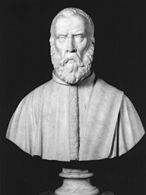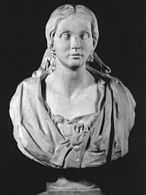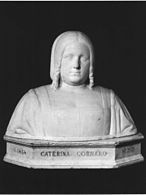Palazzo Loredan a Santo Stefano
Palazzo Loredan a Santo Stefano is a palace in Venice in the Veneto region of Italy . It is located in the Sestiere of San Marco with a view of Campo Santo Stefano next to the Church of San Vidal . The Rio de San Vidal runs behind the palace .
history
Before it was bought by the Loredan family in 1536 and restored by the architect Antonio Abbondi , the palace was a group of neighboring Gothic houses owned by the Mocenigo family. The houses bought in this way were completely restored and combined into a single building as the residence of a patrician family.
After the fall of the Republic of Venice , the last member of the Loredan family sold the palace to a businessman in 1802–1805. In 1813 the Regio Demanio (real estate management of the Veneto region) bought the palace and made it the seat of the war ministry and the associated court martial, as well as the residence of the governor. From 1855 to 1862 the palace was the seat of the Provincial Building Administration. For this purpose, the south wing was radically adapted to office use. In this context, an intermediate floor was installed on the main floor. In 1888 the palace became the seat of the Istituto Veneto di Scienze, Lettere ed Arti , but it did not move in until 1891. On this occasion, numerous restoration and furnishing works were carried out.
description
The originally Gothic ensemble of buildings now has a simpler front that runs a long distance along Campo Santo Stefano and a shorter, but richer facade.
The multiple arched window on the long side consists of eight individual windows and nine Corinthian columns. The side facing the Campiello Loredan gives an idea of the previous architectural style. The façade facing the Santo Stefano Church is more richly decorated , with a masterful stone façade reminiscent of the style of the long side, created by Giovanni Gerolamo Grapiglia .
Inside you can see the large entrance hall, which uses many elements that belonged to the houses that used to be on this site. The column capitals are of Gothic origin and were probably reused. To create this entrance hall with the double staircase to the main floor, the outer vestibule, which stretched in front of two of the houses, was closed by a wall; you can still see the puteal with the coat of arms of the Mocenigos inside. The magnificent monumental staircase, reminiscent of the Scala dei Giganti in the Doge's Palace , was executed by Antonio Abbondi.
The exterior of the palace in the restored version around 1500 provided for the fresco on the long side of the palace with motifs according to Mannerist Tuscan - Roman taste. The painter who did it was Giuseppe Porta , also called Il Salviati . The frescoes highlighted the domestic, civil and military virtues of people in the Roman world, e.g. B. from Lucretia , Cloelia , Porsenna and Mucius Scaevola . The latter was considered the mythical ancestor of the Loredans.
painting
On the ceiling of a room on the mezzanine floor you can see paintings by Jacopo Palma the Younger and Antonio Vassilacchi , dating from around 1600. The four paintings show scenes from the Old Testament and probably moved here from other rooms in the palace around 1800.
In 1752, for the election of Doge Francesco Loredan , a room on the main floor was decorated with frescoes. These are ascribed to Giuseppe Angeli and the squares to Francesco Zanchi . The stucco work in the same room, however, is attributed to Giuseppe Ferrari .
The fresco by Gian Carlo Bevilacqua , called Allegoria napoleonica , is of particular interest ; this painting was recently restored after the Germans tried to destroy it in 1814.
Panteon Veneto
The Pantheon was created in 1847 when the Istituto Veneto di Scienze Lettere ed Arti was asked to attend the IX. Congress of Italian Scientists to create a collection of images in the form of busts or medallions of great Venetians who distinguished themselves in their professions (politicians, scientists, artists, military, writers etc.) and who lived in Veneto for a long time, from ancient times to to the 18th century. The busts and medallions that make up the Panteon Veneto were removed from the Doge's Palace in 1955, brought to Ca 'Pesaro and finally collected in 1989 by the Istituto Veneto di Scienze, Lettere ed Arti in the Palazzo Loredan a Santo Stefano, where they are now displayed in the atrium able to see. The project, started in 1847, was completed in 1931: the last bust added to the collection was that of Carlo Gozzi .
- Panteon Veneto
Sala Luigi Luzzatti
To mark the centenary of his appointment as President of the Council of Ministers, a room was dedicated to Luigi Luzzatti thanks to a donation from the Banca Populare di Verona ; he was also president of that bank. In this hall photographs, documents, personal items and furnishings of the scholar and statesman are exhibited. In the room an oil painting by Dieudonné Jacobs and a bronze bust depicting Luzzatti, various sculptures, medals, plaques, honors and the seat of the deputy are shown. The desk and armchair of the Roman house are also on display.
Individual evidence
- ^ Panteon Veneto. (PDF) 2010, accessed November 28, 2019 .
swell
- Elena Bassi, Rodolfo Pallucchini: Palazzo Loredan e l'Istituto Veneto di Scienze, Lettere ed Arti . Istituto Veneto di Scienze, Lettere ed Arti, Venice 1985, OCLC 489933535 .
- Fabrizio Magani: Il "Panteon Veneto" . Istituto Veneto di Scienze, Lettere ed Arti, Venice 1985, ISBN 88-86166-58-3 .
- Giandomenico Romanelli, Alberto Craievich, Lorenzo Fellin, Fulvio Caputo: idea progetti restauri 1999–2009, Palazzo Loredan e Palazzo Cavalli Franchetti l'Istituto veneto nelle sue sedi . Istituto Veneto di Scienze, Lettere ed Arti, Venice 2009, ISBN 978-88-95996-18-9 .
Web links
Coordinates: 45 ° 25 ′ 58.2 ″ N , 12 ° 19 ′ 47.5 ″ E











